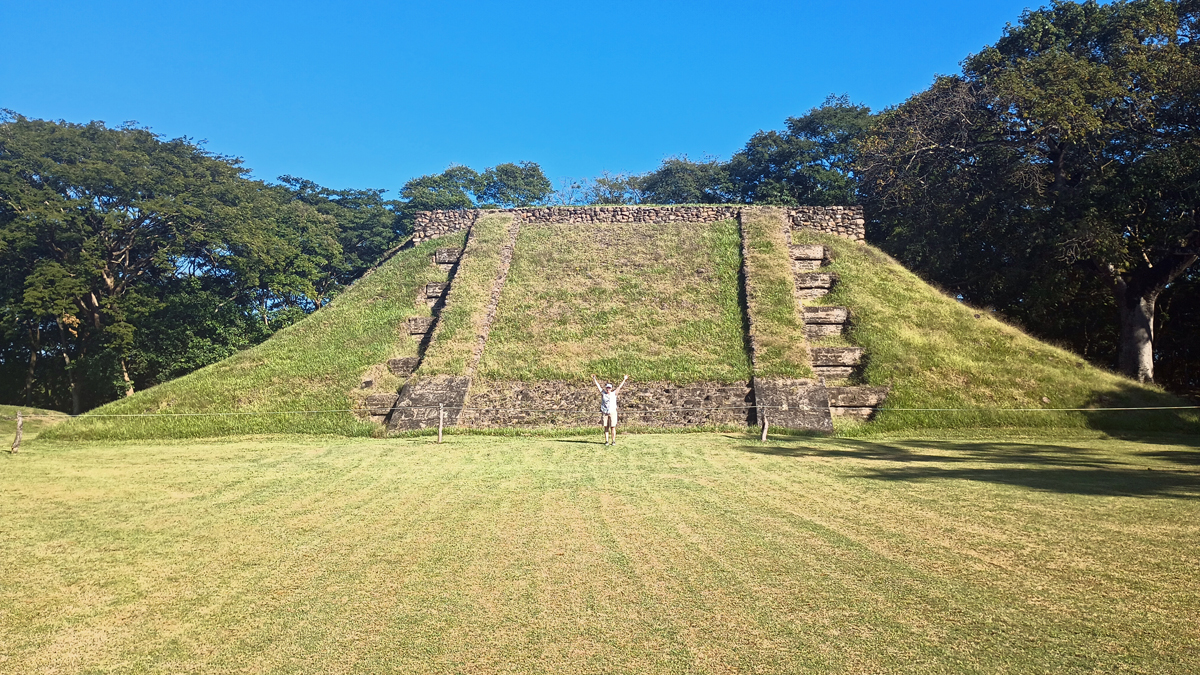Today was one of our longer days of driving, but we broke it up with a couple of absorbing stops of archaeological interest.

Republic of El Salvador
The Mayan farming village of Joya de Ceren is the only archaeological site in Mesoamerica that preserves the structures of ordinary villagers, rather than only those of the rulers and elite. That's due to the fact that the pyramids and buildings of the rich were made of stone and brick, while the homes of the peasants were constructed of mud and thatch that typically wore away with time – but not in this case.

Mayan farming village

Artifacts in the museum
The village of Joya de Ceren was preserved by its destruction when the eruption of Loma Caldera Volcano, around 650 AD, covered the village in seven meters of volcanic ash, freezing the village in time, much like Pompeii. Unlike Pompeii, however, early volcanic tremors gave the residents of Joya de Ceren time to flee, and it's believed no lives were lost.

Joya de Ceren

Pompeii of the Americas

A temazcal sweat lodge, lower left
The long-buried village was rediscovered in 1976, when one of the adobe homes was uncovered by a bulldozer during construction of a grain silo. Excavation work began in 1978 but was quickly abandoned due to El Salvador's civil war, resuming again in 1988. Many items recovered from Joya de Ceren are on display in its museum, which also offers a multi-lingual overview of the site’s known history. Excavation and study slowly continues today.

Jana at Joya de Ceren

Crepe ginger

False bird of paradise
Late in the afternoon, we visited Cihuatan Archaeological Park, the most extensive pre-Hispanic archaeological site in El Salvador. Only a small portion of Cihuatan has been excavated, but archaeologists estimate there were once over 25,000 inhabitants. The archaeological park preserves 180 acres, about one-fourth of the original city's footprint.

Largest archaeological site in El Salvador
The architectural style of the Cihuatan structures is Mayan, but the city was built sometime after 900 AD, well after the collapse of the Mayan civilization, and its occupants are thought to be of various ethnicities, including Pipil, Maya, and Lenca.

Jana claims Cihuatan

The main pyramid
A sculpture has been found at the base of Cihuatan's temple signaling that the structure was dedicated to Xipe Totec, also known as “Our Lord the Flayed One.” Xipe Totec was an important figure to warriors, and part of his celebration involved wearing human skins taken from sacrificed prisoners of war. Seems excessive, but who am I to judge?

Crazy cactus

Watch your step!
Around 1100 AD, most of the city of Cihuatan was destroyed by a massive fire. Spear points were found throughout the burn layers, and human remains were found in the drains of the acropolis dating from the time of the fire, leading one to conclude that the fire may not have been accidental.

Ball court

Beautiful bougainvillea
Lodging: The Mayan Grouper in Suchitoto. They advertise themselves as a tiny hotel, but we were surprised to find that there are only two guest rooms, and we were the only guests. Our room was huge, with a king-sized bed, a mini-fridge, and an unbelievable view of Lago Suchitlan. Outside the room is a beautiful garden and more spectacular views of the lake. There's private parking inside the hotel's locked gate, and it's an easy walk to town center. What a find! We're staying two nights.

Gated entrance to The Mayan Grouper

Our accommodations

Lago Suchitlan

Our private paradise
After settling in, we walked down the hill to Suchitoto's lively main square for dinner. This is not the sleepy little mountain town that we'd imagined. It was Sunday night, and there was music in the square and people milling all about. Suchitoto is one of the few towns in the region that avoided total destruction during the civil war and thus retains much of its colonial charm. I'm glad we came now, because this place will no doubt be overrun by tourists in a few short years.
We had dinner at Restaurante Las Farolas, on the corner of the square. We both opted for burgers and fries. Don't judge our ordering hamburgers again. They were delicious.
Later, we hung around in the square for a while, listening to a guy play the pan flute and enjoying the hubbub. There's a beautiful church on the square called Parroquia Santa Lucia. You may recall the very similar-looking church in Juayua by the name of Iglesia Santa Lucia. Lucia must have been quite a saint!

Parroquia Santa Lucia

Parroquia Santa Lucia interior

Pan-flute man

Lovely lighting